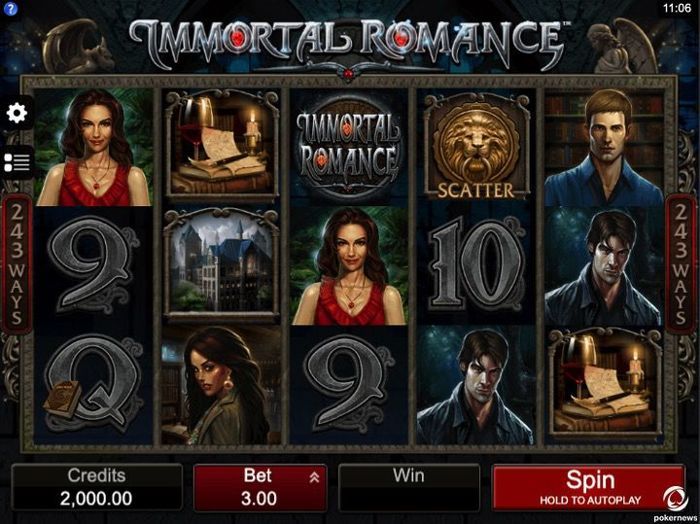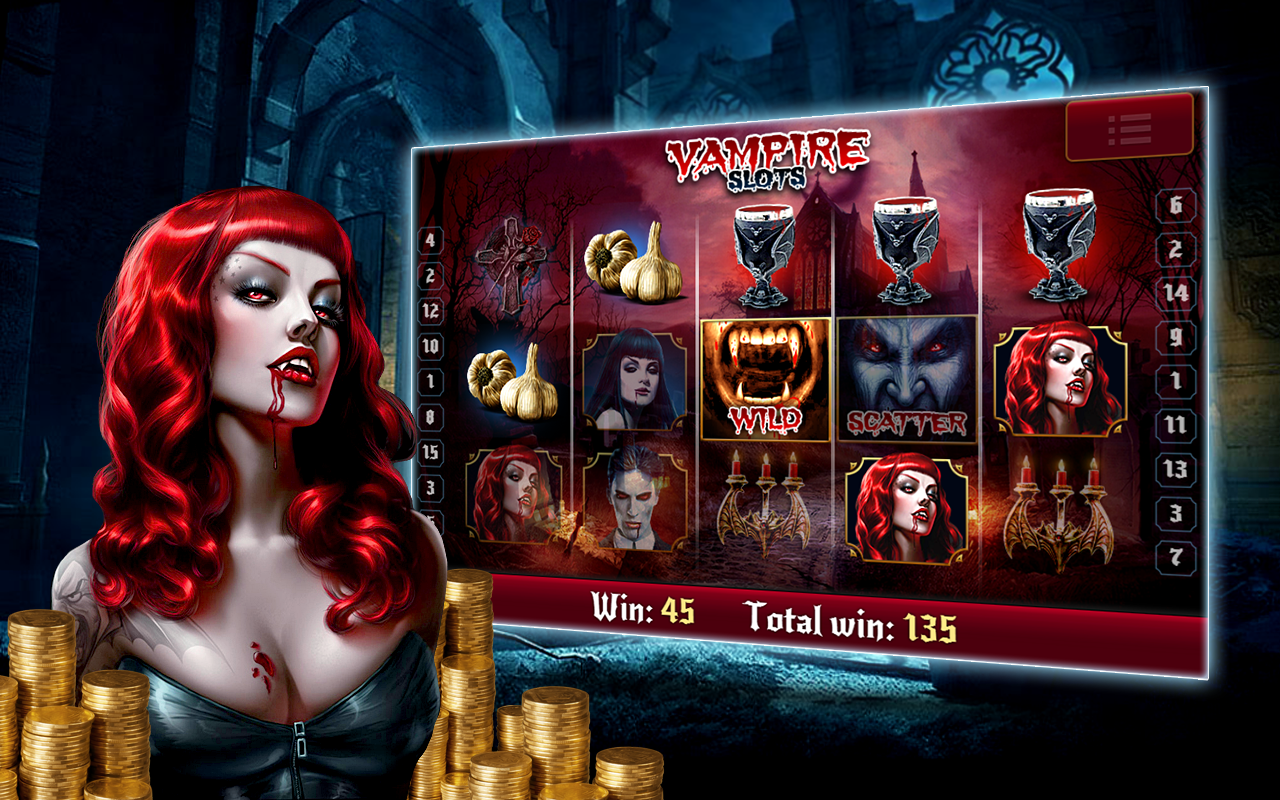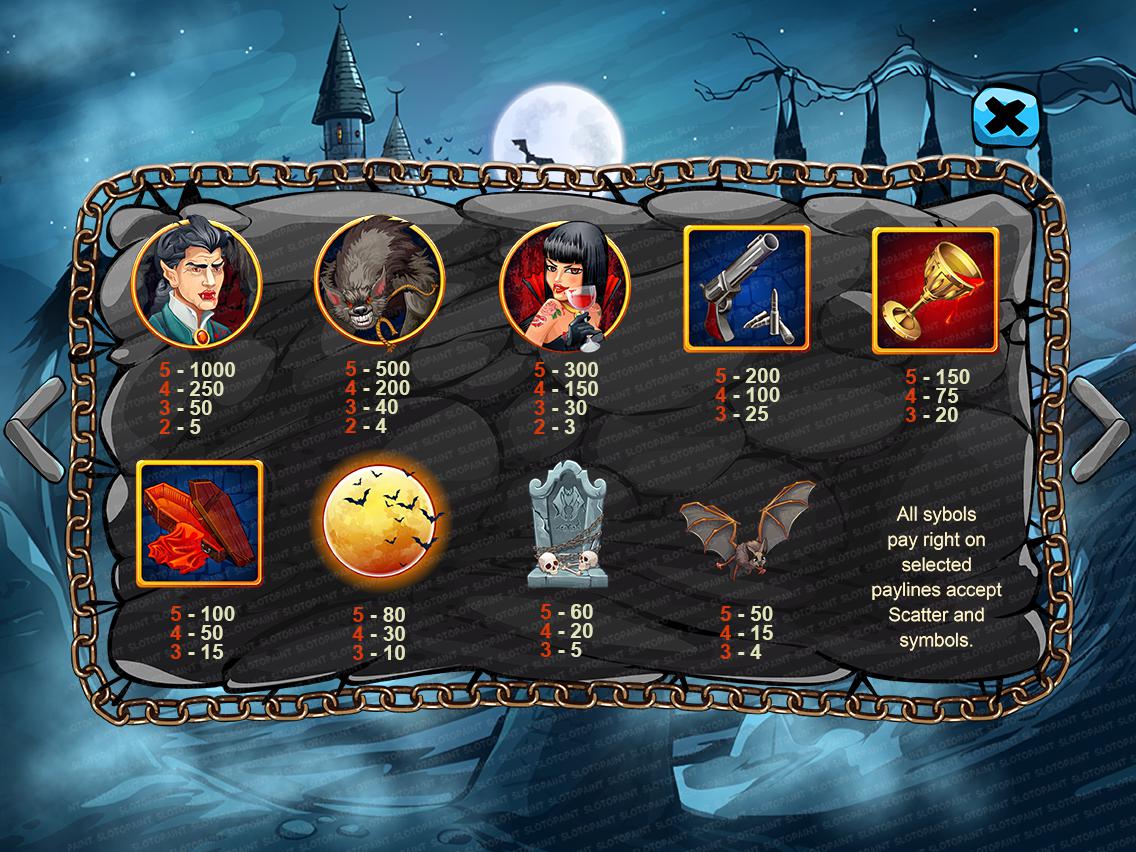Vampire Slot Machine
Vampire: The Masquerade - Las Vegas is a browser-based slot machine game, using the setting of Vampire: The Masquerade. A January 27, 2016 press release announced that Foxium and White Wolf had struck a deal for Foxium to license the Vampire IP for a slot machine game 2. In November 2017, they released Las Vegas, a 5x3 slot game themed around Vampire, featuring a vampire and his prey in a. The Vampire Night slot machine is a different beast altogether. It's a simple 5-reel game from established online casino developer, EGT. There are two vampire characters, cups of blood, and various magic potions. But the game lacks any atmospheric music or horror-style sound effects. Vampire Saga Free Vegas Casino Video Slot Machines Android APK herunterladen und installieren. Time to spin for hours and enjoy all Faze Vs Complexity exciting. Ufc Fight Night 143 Dracula's Family slot machine has prepared for gamblers a meeting with the least bloodthirsty and the most generous vampires.
May the 26th, 1897 saw the publication of Bram Stoker’s “Dracula”. The seminal gothic novel that has shaped an entire genre of writing from literature to cinema, from TV to comic books. No one needs to have vampires explained to then, such is the impact that one Count Dracula has had on the collective consciousness of modern culture.

In a few years after its publication the internal combustion engine would revolutionise how we get from A to B, but at that point in history were are held together by the steel of the horseshoe and the railway line. Information could be tapped from one end of the earth to the other in a matter of minutes but we were still a few decades away from log-distance conversation and whilst the frontier had been tamed pockets of darkness remained that enraptured our collective imagination. Despite all our progress, we still stood, pilgrims on the edge of a forgotten forest.
From that dense thicket Stoker’s creation crept his way into the hearts and minds of an unquenchable readership. Dracula: a symbol of primal sophistication, of the unknown and the unexplained turned into cold, terrifying flesh has remained with us for well over a century and in some way has been with us for as long as we have had the time to sit and stare into the darkness.
Folklore
Dracula is the accumulation of centuries of folklore, a creation sitting deep inside a recess of the human psyche. Count Dracula was not the first literary figure to drink blood, in fact he wasn’t even the first vampire. Stoker’s success is a combination of his narrative style, a realism brought about through a first-person narrative told as an epistolary novel through letters, diary entries, newspaper articles, and ships’ log entries and the unnerving refinement of Dracula’s ancient aristocratic savagery.
He may be the first mythical blood-sucker to live in a castle, dress in fine clothes and speak with Victorian elegance but Dracula is one of the last in a long line of vampiric nightmares that have peppered cultures for thousands of years.


Lamashtu was a Mesopotamian demon. A female monster who would prey on pregnant women and steal their babies during breast-feeding. She would take the child, feast on its bones and drink its blood but looked nothing like the vampires we know today. She was part lion, part donkey, part bird, with other animals thrown in for good luck depending on who was telling the story. All this from a culture that thrived 5000 years ago and was nothing but dust and remnants long before Western civilisation had made its mark.
The Ancient Greeks had the Strix, a large-headed bird that fed on human flesh and blood. The Philippines have the Manananggal, “a malevolent, man-eating and blood-sucking monster or witch”, usually female with hug bat-like wings, with an abhorrence for garlic and salt. The same monster exists in Malaysia, but is called a Penanggalan, a word meaning “detach” or “remove”. In aboriginal Australia there is a creature called Yara-ma-yha-who, resembling a little frog-like man with red skin, no teeth and suckers on the ends of its hands and feet. The Yara-ma-yha-who would drop down out of trees and use its suckers to drain the blood from its victims. In the Caribbean you have the Soucouyant, “a malignant witch believed to shed her skin by night and suck the blood of her victims.” In the Celtic culture of Scotland and Ireland you have the Baobhan Sith, “a beautiful women who would seduce their victims before attacking them and draining their blood.”
That list could go on indefinitely, with just about every place and people imaginable having a blood-sucking monster to haunt the nightmares of its children. The range of people and places is extensive enough to reach right the way around the world and whilst the form that the creature takes will vary its preoccupation with imbibing human blood remains a constant.
Hunting Vampires
By the time we catch up with Dracula in the pages of Stoker’s novel, the Count’s requisite to preserve his own life by drinking the blood of his victims is becoming an increasingly problematic undertaking in his sparsely populated Transylvania outpost. The arrival of strangers to Castle Dracula serves him up a solution:
“I long to go through the crowded streets of your mighty London, to be in the midst of the whirl and rush of humanity, to share its life, its change, its death, and all that makes it what it is.”
London was the centre of Western society, the most populated city in the world and a veritable buffet of delight for a city still haunted by the murders of one Jack the Ripper and now it too could join the rest of the world, boasting its own blood-sucking terror.
The vampires that we recognise today were formed in the imagination of 18th century Eastern Europe and the horror the was left trailing in the wake of a cholera epidemic. As thousands died the ground swelled with decaying bodies giving grave robbers an endless supply line, but what waited for them in the thick black earth soon had them scrambling for cover.
The bodies that were uncovered had grown, as had the nails and hair and most horrifying of all were the traces of blood that smeared the sides of the mouth. Those who witnessed the uncovered graves drew what would appear to be a fairly obvious conclusion if you have no understanding of science:
The dead were rising up from their graves and in the dark of night they were hunting out victims, whose blood they would drain in an attempt to replenish that which they had lost.
This began what we now refer to as the Vampire Hunts of the 18th century. Eventually things got so out of hand that experts were sent out to dispel the myths and the act of vampire hunting was made illegal. The hunts might have stopped but the myth lived, passed on down the generations.
It was through these stories that many of the characteristics we now associate with vampires were formed:
Immortality, blood-drinking, the stake through the heart…”
Other traits were implied but not necessarily stated, something the Stoker made sure to do, along with adding a few flourishes of his own:
The fear of the crucifix, an aversion to sunlight and having no reflection are all attributes that Stoker can lay claim to but there are two more influences that needed to make their way in the world before Count Dracula could grace the pages of the famous novel.
Vlad and Polidori
The first is Vlad the Impaler. Dracula takes his name from the one that Vlad inherited from his father, ‘Dracul’, meaning Dragon, a name his father earned by joining the Order of the Dragon. Vlad also had something of a thirst for blood, albeit a less literal one. His method for killing ties in pretty nicely with this nickname and also helps to draw a connection with the obligatory stake through the heart. Despite Dracula’s bad reputation, if the stories about Vlad are to be believed, he puts our famous count well and truly in the shade after it was written that he impaled 20,000 of his own people outside the city of Targoviste as a warning to the pursuing Ottomans of his carnal barbarity. The gesture worked, as the Ottomans saw the decaying bodies picked apart by crows and high-tailed it out of there on their way back Constantinople.
The second influence comes from another 19th century author, John Polidori who wrote his novel “Vampyre” a good 80 years before Stoker’s “Dracula”. Polidori was good friends with Percy and Mary Shelly and Lord Byron and would often holiday together. On one particular trip to the Italian lakes the weather turned unexpectedly sour, rendering much of their time planned eating and drinking in the baking sun void. As a remedy to the boredom that ensued the four writers told ghost stories before one amongst them decided they could all do a lot better and devised a competition between them all to see who could write the scariest novel.
Whilst Percy Shelly and Byron contributed nothing to the outcome of the competition two novels would be born from the fruits of its labour. Unfortunately for Polidori, despite defining the vampire in the mould that we know so well today he was up against Mary Shelly, inspired by her knowledge of gothic conventions and modern science she penned the infamous “Frankenstein”, a novel that not only won the competition but became what is considered by many to be the first example of science fiction.
However, Polidori should not have been disheartened by his efforts. Despite being less well-known his novel went on to form the basis for all vampire fiction. Stoker took more from Polidori than I’m sure he would care to mention but it is undeniable that without his influence it is unlikely that “Dracula” would have appeared in the precise form that it did.
Along with the influences we need to be aware of there is at least one we need to ignore. If you look in the wrong places you might read of a tale from Ancient Greece about Ambrogio, a mortal who falls in love with Selena, the love interest of the god Apollo. Ambrogio does the only thing he can do to counter such overwhelming odds and makes a deal with the devil, or Hades. He agrees to steal Artemis’ silver bow in exchange for the love of Selena. Of course, Artemis catches him and makes curses him, making all silver cause him agonising pain. Then things get a little weird…
Artemis feels sorry for Ambrogio and makes him immortal, gives him super strength and fangs for him to kill animals with, which he duly does and then uses the bold to write love poems to Selena. He then takes things to their natural conclusion and kills Selena by drinking her blood. By doing so her body dies but her soul lives on forever, freed from the shackles of her physical form.
There might be a tonne in there that alludes to the vampire myth but most of it was written after the fact. This is not a Greek myth but a terrifying and crazy story masquerading as one and as such needs to be ignored when concentrating on the Stoker’s influences.
The Rise of Vampire Fiction
Stoker might not have invented vampire fiction but in 1897 he perfected it and from this point on, as far as the vampire genre is concerned, the rest is history.
If I was to list the vampire films that have been release in the 20th century alone I would be here all week but there are a few noticeable standouts that need a mention.
It took just under a century but finally someone was brave enough to make a film called “Bram Stoker’s Dracula”, a film that was as 90s as it was Victorian. The cast were huge, the film was huge and the Count’s head was, well…huge. With Buffy just around the corner the 90s were about to go vampire crazy.
Nosferatu was the first vampire movie made…Wait, scrap that. Nosferatu is one of the first films ever made. Released in 1922, Nosferatu was directed by F.W. Murnau, a man determined to make the scariest vampire movie he could and despite being denied the rights by the Stoker estate to use any material from the novel made a film that about vampires and was, most importantly utterly terrifying.

What Nosferatu was unable to do, “Dracula” had no issues with and in 1931, one the most iconic retellings of the novel hit the big screen. Prior to Christopher Lee’s performances, Bela Lugosi owned the role and was the Dracula that most people thought of when the name was mentioned.
”Interview with a Vampire”, “Lost Boys”, “Blade” and my personal (and hipster) favourite, “Let the Right One In” are few notables without me daring to mention “Twilight” or any of the TV shows that grew in popularity in the 90s. Vampires are mainstay of modern culture. We love them because they are scary, smart and sexy.
No one wants to end up as a zombie but being a vampire comes with plenty of perks. You can live forever, have super strength, great teeth and get to wear a cape. He might not have started the stories in 1897 but what Stoker did with his seminal novel was define the genre and create a legacy that will live as long as its central character.
Vampire Slots Games
There have been quite a few vampire themed slots games over the years and when they have been good, they have been really good. Unfortunately there are plenty out there that are probably best left where they are. For this reason I’ll be keeping the list down to a much more manageable 5, but can assure you that some of the games on this list are as good as any game you have played before.
Blood Suckers
Blood Suckers is a game we have looked at before and for seriously good reason. Whilst you’ll find much more attractive slots games with even better features you will not find one about vampires with a house edge as low as this one. Quite simply, the best value for money vampire themed game out there, making it a must have on our list.
Dracula
Did I mention that Blood Suckers was a Net Entertainment game? I didn’t think so. Well, Dracula is too and despite being an old timer now, this game still holds up as well as most other modern slots games. It looks fantastic, has some amazing features for you to sink your teeth into and is offering decent value for money too.
Immortal Romance
What’s that? A vampire game that isn’t from Net Entertainment. Surely it isn’t up to much? Think again people. Microgaming’s Immortal Romance is the highest scoring game on our list, coming in with a hugely impressive 10 out of 10. This game has it all. Enough of the praise already. Just give the thing a spin.
Blood Eternal
This BetSoft game has a tough gig on its hands. First of all it is sitting here in amongst the big hitters of Net Entertainment and Microgaming and secondly the house edge is not as good as we normally want it to be. But if you can put that one slight aside this game can just about hold its own with the big boys. It looks amazing and has fantastic bonus features.
Vampire's Kiss Slot Machine
Blood Suckers II
Vampire Slot Machine
Blood Suckers II is the better looking, more engaging younger sibling of Blood Suckers. It might flatter to deceive a little, by not offering as good value as the original but sometimes it’s good to be led astray by something exciting and shiny.
Vampire Rose Slot Machine
Leave a Reply
Vampire Bats Slot Machine

Vampire Slot Machine
You must be logged in to post a comment.